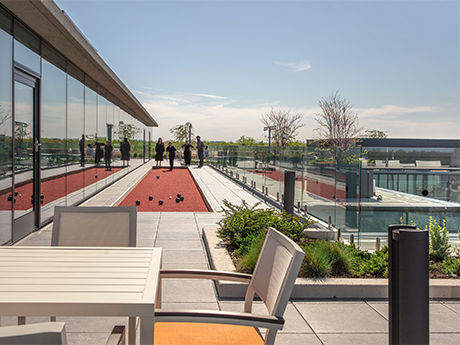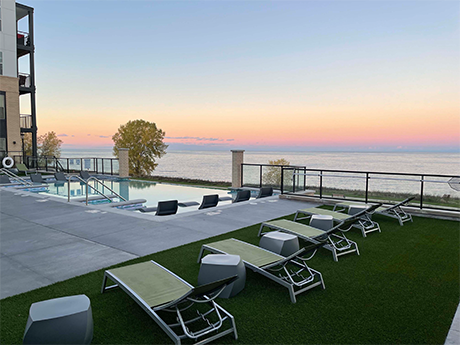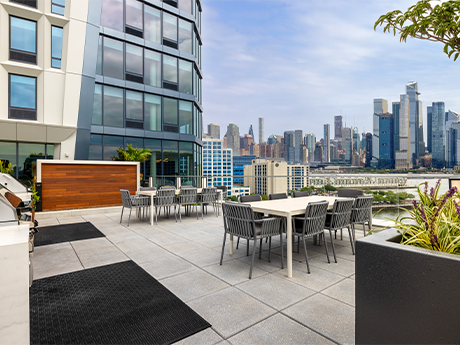Amenities are the personality of a multifamily property. They proclaim a community’s individuality and lure tenants with promises of a fun, relaxing or convenient lifestyle.
What counts as a multifamily amenity today? If most renters and homeowners are accustomed to robust Wi-Fi or controlling their heating and air conditioning through their phones, is a smart thermostat or bulk internet something to advertise as an “extra,” or are these features a given nowadays, like a fridge or a microwave?
“Want versus need is a spectrum when it comes to multifamily amenities,” says Meg Spriggs, managing director of development, Americas, with New York City-based Lendlease.
“The amenities renters need do not necessarily have the same wow factor as those they may want. In fact, you can’t even see some of them, such as fast and reliable internet service. Fitness centers, package systems, dog runs and electric vehicle (EV) charging stations are other check-the-box items that, in some cases, are non-negotiables,” says Spriggs.
Wi-Fi and EV outlets may be essentials, but they’re not always clinchers for prospective renters on the fence about where to live. This is when the wow factor takes over.
Recording studios, on-site beekeeping, private speakeasies, meditation pods, maker spaces, wine cellars and golf simulators with putting greens are just a few examples of how developers are souping up many of today’s new or rehabbed Class A properties.
“Across all our brands, we are typically providing pools, community spaces, fitness facilities, package management systems, pet parks and coworking spaces,” says Alliance Residential Co.’s Donald Santos, managing director, Carolinas and Mid-Atlantic.
“As we move upward in rental price point, we are including a wide range of amenities, some of the more notable being Big Green Egg stations, pizza ovens, art galleries, wine and liquor storage and resident beer taps. In one of our newest communities, we even have a champagne vending machine.”
Headquartered in Scottsdale, Arizona, Alliance ranks No. 29 on the 2024 NMHC Top 50 Owners list with 35,405 units as of Jan. 1.
Beyond the champagne vending machine, Alliance delivered a speakeasy in August at The Boulevard, a 238-unit, roaring ’20s-themed community located in the South End neighborhood of Charlotte, North Carolina. The space can only be accessed via a door integrated into a bookcase. Once inside, residents can relax in a Great Gatsby-inspired lounge complete with a bar and beer taps.
“Many of our amenities are as much aspirational as they are utilitarian,” says Santos. “When prospective residents see something special like a pizza oven while touring, it is imprinted in their mind and informs their lease decision. They may rarely or never even use it, but they could, and that’s enough in many cases.”
Implicit in the wow-factor strategy is offering amenities that are different from competing apartment properties in the market.
“We are currently working on a project in Nashville, which has a very long, narrow, unusable space that doesn’t get a great amount of sunlight,” says Ali Gagliardo, associate principal and director of interior design with Cooper Carry, an Atlanta-based architecture and design firm.

“We decided to make it into an edgy, moody speakeasy that has a bowling alley. The client loved the idea, and we have yet to see this amenity in any other developments. We had a similar situation on another project with a basement space. We decided to design around that concept and make it feel like a rec room in your grandma’s house. Wild patterns, unique lighting, gaming and viewing rooms as well as a workshop were all included to bring that concept together.”
Wow factors aren’t reserved solely for potential tenants. Future investors also need to be swept off their feet. “We want prospective buyers to light up when touring one of our communities,” says Santos. “When you hear an investor say, ‘wow, that’s cool’ while on tour, you know that you’ve struck a chord.”
How to Choose Amenities that Best Pair With a Property
Pools and fitness centers are examples of tried-and-true amenity workhorses, but how do developers know when to push the envelope further? Selecting the right mix requires fine-tuned market research and an intimate understanding of local prospective renters.
“Our clients task us with helping them with the overall concept of the development,” says Gagliardo. “They will usually come to us with some initial data that gives us an idea of our target demographic, the typical rent prices and who they consider to be their competition. From there, our team will do some independent research. We’ll research the surrounding buildings and their amenities, unit packages and any special features. Often, we will also go tour properties to see what we’re up against. Our goal is never to match the projects before us, but to exceed them.”
NexMetro Communities develops luxury build-to-rent (BTR) developments in the Phoenix; Dallas-Fort Worth; Austin, Texas; Atlanta; and Tampa, Florida, markets. The Phoenix-based company has been developing Avilla-branded neighborhoods since 2012 and has subsequently learned what works and what doesn’t.
“Based on location and demographics studies of the area, we selectively have included kid play areas and pickleball courts in our neighborhoods,” says Linda Coburn, national vice present of asset management. “Our company conducts an in-depth market demographic analysis to determine not only where we want to build, but who we are building for.”
Sometimes a Class A amenity is a service, versus a physical space. This is where programming comes in. A property manager can breathe life into common-area spaces in a variety of ways.
“Price point informs [amenity selection] to a large degree,” explains Santos. “Where we are targeting top-of-market rents, we must offer a top-of-market experience. Not only does this include the design, furnishing and fixtures enhancements, but also the activity programming in such spaces.”
Examples include wine nights hosted by a sommelier, DJs spinning by the pool, catered resident dinners or yoga or bootcamp classes in the fitness center.
“There was a period of time where there was a battle for who could build the most amenity space, but now there has been a reversion in common-area size, but with an increased focus on the richness of the experience within those spaces,” says Santos.
Just as multifamily design and architecture trends change with the times, management services, too, are evolving.
“Looking ahead, we anticipate the introduction of AI-driven amenities, such as concierge services for scheduling appointments and managing smart home features,” says Gus Milano, president and chief operating officer of Secaucus, New Jersey-based Hartz Mountain Industries.
“We expect to see augmented reality and virtual reality amenities emerge, including VR rooms for simulated workouts or virtual cooking classes,” Milano says.
Because services play such a major role in a successful amenities offering, excessive square footage is not always needed.
“More is not always necessarily better,” says Santos. “Ten thousand square feet of beautiful, thoughtful amenity space can be more impactful than 20,000 square feet of amenity space where you can tell the developer ran out of ideas and/or money on filling the space.”
Katy Slade, principal and founder of Mintwood Real Estate, adheres to a similar philosophy. “Amenities do not need to be heavy consumers of space,” she says. “Instead, they can just offer something extra special outside the four walls of the apartment.”
Mintwood is a Dallas-based multifamily and mixed-use developer that focuses on Texas markets including Dallas, Austin and Houston as well as Raleigh, North Carolina, and Oklahoma City.
Slade explains that Mintwood’s smallest project, 212 Melba in Bishop Arts in Dallas, has fewer than 2,000 square feet of amenities, while the company’s largest building, Peridot, also in Dallas, includes more than 15,000 square feet of amenities.
“We devise a unique amenity program for each property, evaluating who our target residents are and what meets their standards. We’ve found that this customized approach has enabled us to hit our leasing goals more quickly because we always keep that ideal resident at the forefront of our minds.”
According to some developers, renters come for the physical amenities, but they stay for the services. “We’ve seen that renters increasingly prioritize amenities that enhance convenience and connectivity,” says Milano.
“Features such as high-speed internet, in-unit washers and dryers, coworking spaces and pet-friendly policies consistently attract new renters,” emphasizes Milano. “For renewals, strong resident retention hinges on satisfaction with responsive on-site maintenance, effective property management and active community engagement through events and activities.”
Hartz Mountain developed Hoboken Point in Weehawken, New Jersey. The property, which opened in September, provides more than 40,000 square feet of amenities.
Most service-based amenities don’t require corresponding architecture. A wine tasting, for example, does not need a special type of room. For this reason, flex spaces come in handy when developers seek to future-proof their buildings.
“Spaces that are flexible have an advantage,” says Diana Pittro, executive vice president of Chicago-based RMK Management Corp. “It is ideal for our property management teams to have the ability to use spaces for different purposes at various times of the day, such as a space that can be used as a breakfast, lunch and work area during the day and then a social gathering spot in the evening for resident events.”
Owners Seek Tangible and Intangible ROI
A trendy set of amenities pays off directly and indirectly. Some owners charge a specific dollar amount for a service, such as EV charging or valet trash pickup, while the costs of other amenities are baked into monthly rental rates.
Installation costs for some amenities or services can be quickly recovered. Roughly speaking, an owner of a 300-unit property might install a smart package room, which ranges from $15,000 to $30,000, depending on the level of tracking and security technology options, and charge each resident a $25 monthly fee. At that rate, it’s only about four months before the installation is paid off and profits begin.
Other package providers charge multifamily clients a monthly subscription service fee for ongoing maintenance, which can range from $200 to $1,000 per month. Developers and property managers can determine how these fees are passed along to the resident.
“There are certainly some amenities that have a more direct measure of revenue generation and thus return on incremental investment, such as bulk Wi-Fi, valet trash or parcel management systems,” says Santos.
“But many of our amenities are purely experiential. For instance, we’ve delivered a community with an art package exceeding several hundred thousand dollars. We cannot isolate the incremental revenue from that offering, but if our goal is to offer the best resident experience within the competitive set, much of that is more qualitative than quantitative,” Santos says.
Multifamily Living Made Easy
One of the benefits of renting comes in the form of conveniences you wouldn’t find as a homeowner. Fast, efficient package delivery, high-speed internet connection throughout multiple workspace layouts and onsite retail are but a few examples of how developers not only wow tenants with amenities, but also make their daily lives less of a grind.
“Today, everyone is seeking experiences and convenience,” says Josué Garza, president of property management at Lynd, headquartered in San Antonio.
“We’ve found that the amenities that best help with lease-ups are the ones that enhance residents’ daily lives like coworking spaces, autonomous convenience stores, pools and rooftop amenity spaces, as well as indoor and outdoor social areas. The best amenities are unique to the location or truly functional and well-executed, not something done just to check a box or utilize dead space.”
Package management leads the charge when it comes to convenience-based amenities. Managing deliveries has become increasingly sophisticated, and developers are keeping up by offering residents multiple options when it comes to package and mail storage and retrieval.
“Package rooms are continuously growing in size as delivery becomes more of the norm,” says Gagliardo. “Beyond the typical package room, which is usually a large room with lots of open shelving for large format packages, we are also finding package lockers being requested in addition to the room.”

Property managers are responsible for storing and delivering more than just everyday Amazon purchases. Furniture deliveries or orders that contain alcohol require special protocols and have legal ramifications, as do deliveries of medications, such as insulin.
“Refrigeration is still controversial as a lot of property management teams don’t want to absorb the liability of a tenant’s medication and special dietary requirements,” says Gagliardo.
“However, we usually will specify at least one commercial-grade refrigerator and freezer within the room. Valet or concierge service has also become very common in metro areas. This service works with property management and delivers packages directly to residents, picks up trash right from your door, walks your pets and generally is there to make your life more convenient.”
In addition to supporting work-from-home tenants, developers are also experimenting with shop-from-home amenities.
“As far as convenience goes, we are trying to design our properties so that you never have to, or want to, leave,” says Gagliardo. “Grab-and-go markets are being incorporated into amenity spaces for basic toiletries and snacks, much like you would find in a hotel. Full barista [coffee] bars with coworking spaces have also become the norm. We are even seeing full-functioning bars being requested.”
Pets and Wellness: Amenity Linchpins
Pets, particularly dogs, play a major role in the lives of renters, and apartment developers have responded. Like most amenities, pet-based features such as dog parks and grooming stations are changing with the times.
Gagliardo says that pet facilities are among the most desired amenities. “They are almost a non-negotiable at this point,” she says. “A few years ago, our clients asked to make sure we provide some amount of space within the project where residents could hose off their animals. That grew to ventilated rooms with washing and drying stations. Today, these spaces are fully designed, built-in rooms that can accommodate several animals at one time.”
Many developers are also including dog runs and play areas in their projects, Gagliardo points out. “There have even been instances, specifically in high-rises, when we have been asked to provide pet relief areas on the higher levels, so tenants don’t need to go all the way down to the street level.”
Coburn says pet owners are particularly attracted to BTR communities, so NexMetro makes special efforts to court this type of renter. “For this reason, we do not have breed restrictions at our communities,” she says.
“We find people with multiple pets or people who have certain breeds that are restricted in [conventional] apartments are especially interested in our dog park amenity and the amenity of a private backyard. In addition, pet rent is, of course, an additional ongoing source of
income.”
Pet rent is a fee landlords charge tenants each month, in addition to their rent. Fees and deposits for pets vary by breed and by community, but they are typically about $30 to $50 per month, in addition to an upfront pet deposit.
Owners know that pets are just one component of a happy, healthy life. Refined wellness amenities also turn heads.
Garza says new technologies such as fitness on demand, recovery stations, which include plunge pools, saunas and stretching rooms are sought after features that renters desire. “We endeavor to demystify the fitness center with free classes, sound healing and other offerings to engage residents in a low-stress environment. This is all part of our Lynd Living wellness initiative.”
Dan Goldberg, president of Chicago-based Core Spaces, also asserts that residents want to live in a community that promotes an active lifestyle.
“With health and wellness at the forefront, many of our fitness centers now include meditation rooms, yoga studios and saunas and steam rooms,” he says. “Our residents are passionate about mental and physical wellness, and they want to have access to these features that will help them live their best lives and thrive.”
Core Spaces, which got its start developing amenity-packed student housing properties, plans to build more than 3,000 Oxenfree-branded BTR units in Dallas-Fort Worth; Denver; Nashville, Tennessee; Austin, Texas; Charlotte, North Carolina and along Florida’s Gulf Coast.
Sometimes wellness amenities consist of tech-heavy investments, but health-based development strategies can be as simple as constructing spaces that make walking an easy and desirable mode of transportation.
Suwanee, Georgia-based CCI Real Estate is under development on Nova River District, located in downtown Rome, Georgia. CCI founder Jeff Warwick says the market is heavily populated with medical and university students from nearby schools and a growing number of young professionals.
“Nova River District’s distinctive amenity is a one-acre riverfront community park that will anchor the revitalized area and integrate the new project into the already established downtown area,” he says. “This amenity was planned with these students, young professionals and longtime Romans in mind, providing a space attached to the multifamily component that will allow for recreation, fitness activities, local artist installations and a walkable lifestyle that is uncommon in this West Georgia community.”
— By Lynn Peisner. This article was originally published in the September/October regional issues of Multifamily & Affordable Housing Business.


